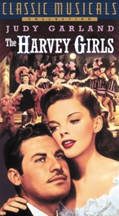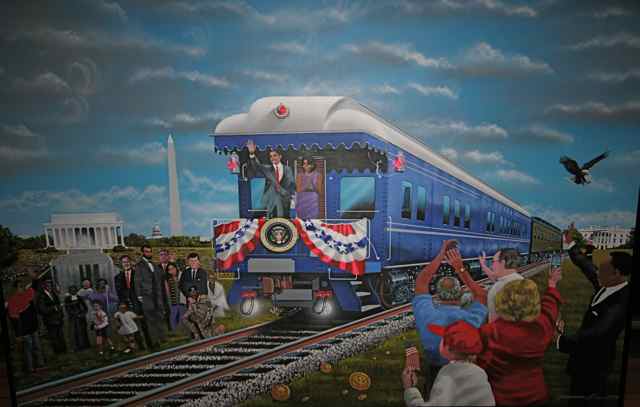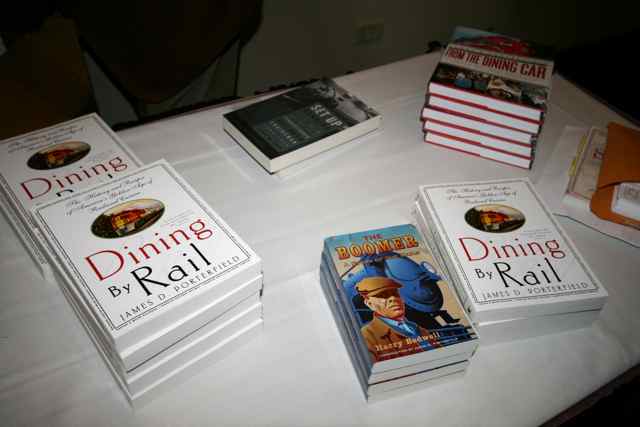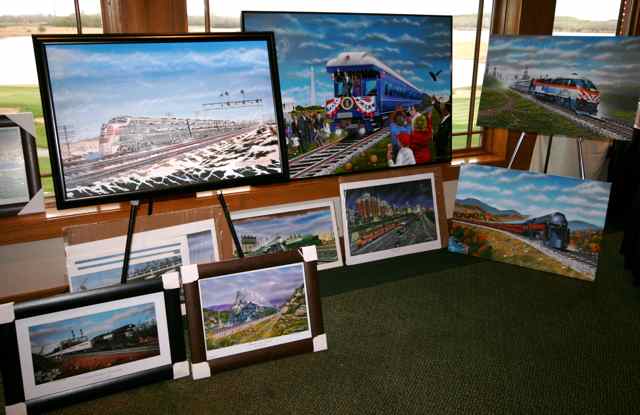Train tracks followed stage paths and
there were usually taverns with food where teams were changed, so food
off the stage, and later the train, was available - except when
derailments or breakdowns took place. Cattle hit on the tracks
was the first dining on RRs - Road Kill.
1856 - First RR bridge across the Mississippi River
1869 - 1st Transcontinental RR across the US - Promitory Point, UT.
"News Butches" sold things on early trains - food items, newspapers,
etc. Self admitted short change artists, the would first sell
salty food going through the train one way, then come back through with
lemonade, much as is done at modern ball parks today.
"20 minutes for Refreshments" was common at train stops. Many
rumors of agreements between the food service and the engineer to blow
the whistle 5 minutes early, causing customers to leave much of their
food uneaten. This would be scooped up and resold to the next
train's riders.
Harvey Houses, inspired by Pennsylvania RR at Altona by the Logan
House, a huge hotel to keep workers at Altona - a dreaded place to
work. Orders for food were wired ahead and food would be ready
when the train arrived.
Fred Harvey in 1860 moved to St. Louis and opened a restaurant.
The Hannibal and St. Joseph RR offered eating houses every 16 miles on
the Santa Fe route. Men waiters got into fights with the local
cowboys, so Harvey went to girl waitresses. Many 18 yr. old girls
were transported west with strict dress and behavior requirements.
 The Fred Harvey Company would recruit women via newspaper
ads from towns and cities across the United States. The women had to be
of good moral character, have at least an eighth grade education,
display good manner and be neat and articulate to work in his
restaurants. In return for employment, the Harvey Girls would agree to
a six month contract, agree not to marry and abide by all company rules
during the term of employment. If hired, they were given a rail pass to
get to their Company chosen destination.
Harvey Girls were the women who
brought respectability to the work of waitressing. They left the
protection and poverty of home for the opportunity to travel and earn
their own way in life while experiencing a bit of adventure.
The Fred Harvey Company would recruit women via newspaper
ads from towns and cities across the United States. The women had to be
of good moral character, have at least an eighth grade education,
display good manner and be neat and articulate to work in his
restaurants. In return for employment, the Harvey Girls would agree to
a six month contract, agree not to marry and abide by all company rules
during the term of employment. If hired, they were given a rail pass to
get to their Company chosen destination.
Harvey Girls were the women who
brought respectability to the work of waitressing. They left the
protection and poverty of home for the opportunity to travel and earn
their own way in life while experiencing a bit of adventure.
From:
http://www.oerm.org/pages/Harveygirls.html
For more information on the Harvey Houses, go to:
http://www.harveyhouses.net/

"No Ladies west of Dodge city and No Women west of
Albuquerque," before the Harvey Girls arrived as workers in Harvey
Houses.
For quick service, there was a Harvey Cup Code. After the
waitress asked what the patron wanted to drink, she would put the
coffee cut on its side for coffee, for tea she'd turn the cup over, for
water she would put the cup on the table. The server then knew
what each patron wanted to drink and could pour the proper liquid.
Harvey Girls served 16 people in 25 minutes, at four 4-top
tables. When troops were coming through, she'd serve 96 in 25
minutes.
Mr. Porterfield said that the 1946 movie, "Harvey Girls" was a good
representation, so we rented and watch it on this weekend.
Before the Civil War, food on the trains was incidental. 1867
Pullman introduced the "Hotel Car" on which riders could sleep, read,
and eat. There was an 8 x 8 ft. kitchen onbaord. The
railroads started the concept of bottled water because of unreliable
sources off the train. Hotel cars failed because the food cooked
onboard created unpleasant odors. Riders felt that only poor
people ate in the same room they slept in, and sleeping cars were moved
from train to train so someone had slept in the car before you.
Soon full dining cars emerged and were transferred from train to train
to make several runs a day.
1880 - the compressed vestibule was being built so car-to-car movement
was possible by passengers. Diners then went to the diners which
consisted of 8 x 18 kitchen; 8 x 12 pantry and the remainder of the car
was 32 x 40 ft. seating of 6 stations of 2 tops and 4 tops. The
Dougan Chime was used to call passengers to dinner (sounds like NBC
chime).
Items invented for use in train kitchens: Bisquick, Sandwich
bread (square topped loaves to save overn space) patented pans with
lids by Pullman. Pressed sawdust logs burned hotter and more
evenly so chefs on RRs were first to use them; Pullman Kitchens
were used in town houses that were compact like train kitchens.
Mr. Porterfield said trains from Chicago to the West Coast only had
diners and their menus to distinguish themselves from other railroads
so one advertised giant baked potatoes (2 to 5 lbs.) while another
advertised very large apples. He has tried to get large potatoes
to cook, but can't find any that big, which originally came from
Canada. He says the largest prepared baked potatoes in a
restaurant today would be at Wendy's, at least 1 lb. each.
This ended his talk and guests had time to speak privately with the
artists, researchers, and authors assembled and to buy their
autographed works. A very enjoyable evening even for non-train
fans. At lease two full tables were Pullman townspeople.
Depot Inn & Suites, La Plata, MO, 2 for 1 discount cards were
distributed to all guests and presentors.









 The Fred Harvey Company would recruit women via newspaper
ads from towns and cities across the United States. The women had to be
of good moral character, have at least an eighth grade education,
display good manner and be neat and articulate to work in his
restaurants. In return for employment, the Harvey Girls would agree to
a six month contract, agree not to marry and abide by all company rules
during the term of employment. If hired, they were given a rail pass to
get to their Company chosen destination.
The Fred Harvey Company would recruit women via newspaper
ads from towns and cities across the United States. The women had to be
of good moral character, have at least an eighth grade education,
display good manner and be neat and articulate to work in his
restaurants. In return for employment, the Harvey Girls would agree to
a six month contract, agree not to marry and abide by all company rules
during the term of employment. If hired, they were given a rail pass to
get to their Company chosen destination. "No Ladies west of Dodge city and No Women west of
Albuquerque," before the Harvey Girls arrived as workers in Harvey
Houses.
"No Ladies west of Dodge city and No Women west of
Albuquerque," before the Harvey Girls arrived as workers in Harvey
Houses.